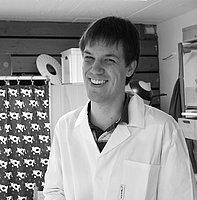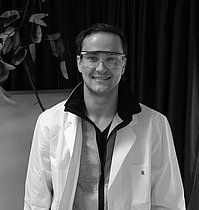Sixty children were looking in awe at those ten weird persons, dressed in white robes and strange glasses: Were these aliens invading their kindergarten Auf dem Backenberg (Bochum) on that morning of the 11th of October? The reality, they were about to discover, was more down to Earth than that, but fascinating nonetheless.
We, the men and women in white, were chemists of the JungChemikerForum Bochum – the 1998 founded local group of young members of the GDCh. And we had brought several intriguing chemical experiments that encouraged them to participate and solve some of nature’s mysteries.
Why don’t water and oil get along?
Ranging from only two-year-olds up to fourth graders, our audience was very mixed. Still, fascination unified them from the very beginning. In their first experiment they had to mix water with oil – but wait, they don’t want to mix?!? That result was quite unexpected for most of our little experimentalists, but we soon explained:
The difference in polarities and intermolecular forces between water and oil makes them like cats and dogs – they form small groups of one kind, but simply don’t get along with each other because of their differences. But what if we take a drop of ink and let it fall into the mixture (of course after multiple attempts with these tricky pipettes)? Ink seems to prefer the company of the polar water molecules, making for a nice visualization of the underlying principles of solute-solvent interactions.
Is brushing your teeth really necessary?
The little explorers then switched to the next experiment: We had to convince them that brushing your teeth in the morning and evening wasn’t just a huge waste of time – a challenge indeed! As model for their teeth a hard-boiled egg was chosen that first had to be properly coated on one half with tooth paste. The children performed this task with vigor and enthusiasm (though maybe not as diligently as we had expected, so we cheated by secretly coating the eggs some more).
Next, the egg was lowered into a glass full of vinegar, symbolizing everyday’s assortment of acids passing our teeth. Also the young participants understood the aggressive properties of this vile liquid after putting their noses over the glass as could be told from the grimaces they made. Having put the egg into the vinegar they observed that bubbles were only formed on the uncoated side of the egg. This being probably the first time these children had ever consciously perceived a chemical reaction our JCF instructors very slowly explained: They carefully introduced the concepts of acids and bases to them, how the stuff that had attacked their noses earlier would react with the egg shell (i. e. calcium carbonate, see below) and produce carbon dioxide, the same gas they knew from soda or lemonade.
2 CH3COOH + CaCO3 –> CO2 + H2O + Ca(CH3COO)2
Acetic acid + Calcium carbonate –> Carbon dioxide + Water + Calcium acetate
However, how come the side they had coated with tooth paste earlier did not show any bubbles? This, we explained, was because the tooth paste contained fluoride, a special ion that helps to prevent damage to teeth by reacting with the hydroxylapatite contained therein and making them more acid-resistant:
Ca5(PO4)3(OH) + F–– –> Ca5(PO4)3F + OH–
Hydroxylapatite + Fluoride –> Fluorapatite + Hydroxyde
What magical substance surrounds us all?
Finally, the children arrived at their last experimental setup, the sight of gummy bears having magically attracted them there. But before they could find out what to do with the sweets (and possibly how they tasted) they had to perform a deceptively easy experiment by submerging an empty glass upside down in a bowl of water. When asked to get out the glass and feel the bottom of it surprise crossed their faces: How could it be that the inside stayed dry? There had been nothing in the glass to prevent water from coming in… or had there been? Could it be that something surrounds all of us at any given time and thus is also inside seemingly empty glasses? When asked these questions the children got thinking: “Nothing”, some children pouted, “the environment” was another cute attempt at solving this riddle. “The sun” was actually an answer that showed quite a lot of insight since light is of course an entirely valid answer.
After some coaxing and hinting the small researchers indeed arrived at air as the substance we were searching for, but as true scientists were very skeptic about it. An invisible substance that is everywhere? We clearly had to visualize this mystical air to convince them. So we let them produce some bubbles by slightly tilting the submerged glass and thus see the otherwise invisible air. As crowning experiment we asked the children to let two gummy bears inside a small boat (made from aluminum foil) take a dive to the bottom of the water bowl without letting them get wet! The kindergartners soon figured out that they could use the same protective hull of air inside the glass to achieve this task and received some sweets for their accomplishment.
We were very delighted by the children’s remarkable enthusiasm to experiment and eagerness to learn about nature’s secrets. Although they probably did not realize it, they had experienced some of the fundamental principles of Solvation Science: The interactions of and interfaces between hydrophilic and hydrophobic solvents (water and oil), the preference of a polar molecule (ink) for water as polar solvent, acid-base reactions in aqueous media (egg shell plus vinegar), water as “tool” in experiments to probe and visualize certain effects (air bubbles). Besides teaching the children these important principles from physics and chemistry, another goal was to inform about them the puzzling work of chemists. Most of them had never even heard of us before and found our alien coats and safety-glasses very interesting. All in all, a very fascinating and instructive day for these small explorers!
This event has been organized in cooperation with the Young Spirits program of Evonik. Please contact us if you are also interested in teaching science to children, so we can supply you with contact to Evonik’s Young Spirits program or the actual procedures of the experiments described in this blog entry.
————————————————————————————————————————————
About the authors






